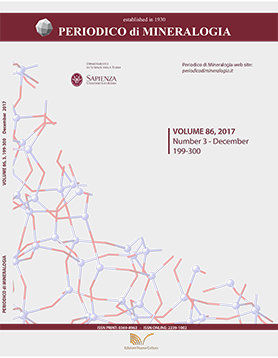Experimental constraints on amphibole stability in primitive alkaline and calc-alkaline magmas
DOI:
https://doi.org/10.2451/2017PM735Keywords:
Experimental petrology, Rhyolite-MELTS modelling, Calcic amphibole, Calc-alkaline melts, Alkaline melts, Na2O/K2O ratio.Abstract
Equilibrium crystallization experiments were carried out on two primitive basaltic rocks (APR16: Na2O+K2O=4.40 wt.%; CM42: Na2O+K2O=2.59 wt.%) with the aim to investigate the amphibole stability in the differentiation processes at deep crustal level, of primitive alkaline (APR16) and calc-alkaline (CM42) magmas. The experiments were performed with different initial H2O contents (0-5 wt.%), at pressure of 800 MPa, in a temperatures range of 975-1225°C. For the explored conditions the amphibole crystallization is limited for both compositions, to H2O in the melt >7wt.%, while the temperature of amphibole occurrence is lower in the alkaline composition (< 1050°C in APR16 and ≥1050°C in CM42). Moreover, amphibole crystallization seems to be influenced by the Na2O/K2O ratio rather than the absolute Na2O content in the melt. This is evident when experimental results on the APR16 and CM42 are compared with experimental data obtained from a primitive ultrapotassic composition (leucite-basanite: Na2O+K2O=4.58 wt.%) and with thermodynamic modelling by the Rhyolite-MELTS algorithm. The comparison shows that amphibole doesn’t saturate the leucite-basanite in any of investigated/modelled conditions, also when an extended crystallization increases the Na2O of melts up to contents like those of calc-alkaline experimental glasses. We conclude that, at pressures of deep crust and hydrous conditions, only primitive liquids whose Na2O/K2O ratio is ≥0.9 are able to crystallize amphibole.


